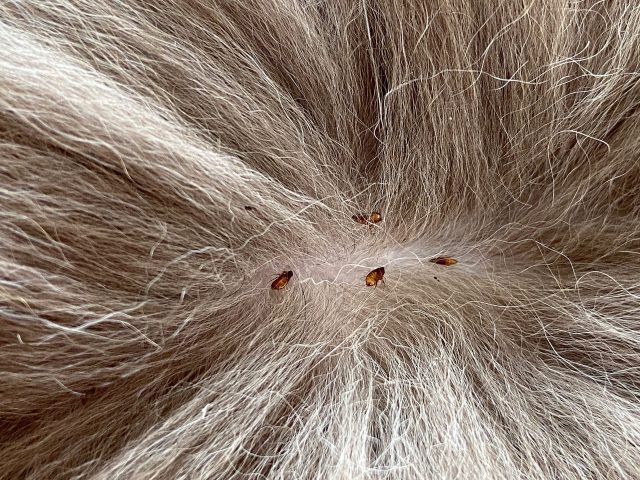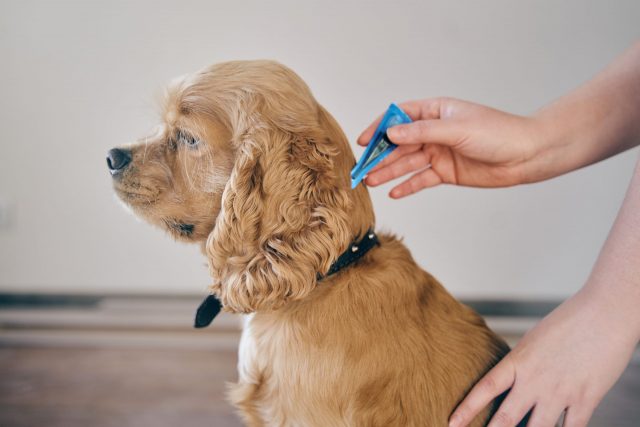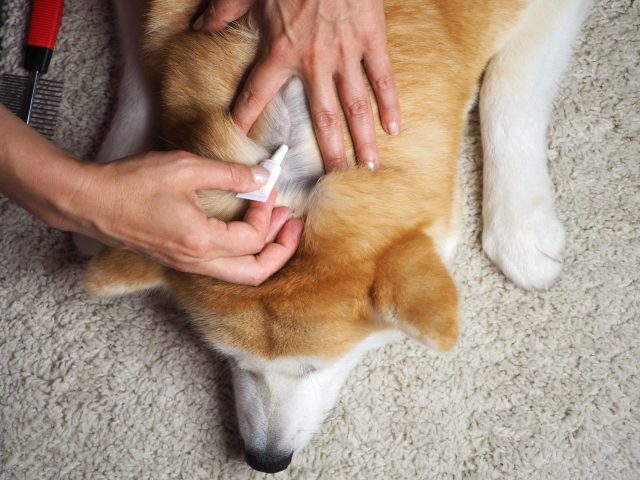iHeartDogs is reader-supported. When you buy via links on our site, we may earn an affiliate commission at no extra cost to you.
While fleas are big enough to be seen, it’s easy to miss the signs of an infestation in your home until you and your dog are crawling with pests. Once you find fleas in your dog’s coat, treating it can be a nightmare. So, keep reading to find out how to identify a flea infestation as well as treat and prevent it.

5 Signs Your Home Has a Flea Infestation
An obvious sign would be seeing the fleas, but since fleas are tiny and fast, they’re not always easy to spot. Below are a few other signs to look out for.
1. Scratching & Biting
If your dog is constantly scratching and/or biting themselves, they may have fleas. Don’t just assume it’s season allergies or an itch! Always check to be sure.
2. Flea “Dirt”
Flea dirt is basically flea droppings and it will look like tiny black or red flecks on your dog – usually on their belly or by the base of the tail. It may look like regular dirt at first glance, but it’s rare that your dog would have lots of dirt in their coat on a normal day.
3. Red, Infected Skin
Dogs may develop red, infected skin if they’re allergic to fleas or excessively biting and scratching. If you start seeing red, irritated, or even bald skin, check for fleas and flea dirt.

4. Flea Larvae
Much harder to see than the actual fleas, the larvae are a dirty white color and measure 3 to 5.2 mm in length. Flea eggs are even tinier, appearing as off-white spots that could be mistaken for crumbs.
5. Small Bites on You
Do you find yourself scratching at what appears to be nothing? Look closer. If you have small red bumps on you it may be flea bites. If you’re getting bitten, chances are you have fleas in your bed. Fleas commonly bite ankles, so look closely at your socks when you take them off to see if fleas are hiding in them.
Treatments for a Flea Infestation
When it comes to fleas, it’s important to follow as many treatment options as possible to ensure that the fleas are removed from your dog, your home, and your yard. Depending on the severity of the infestation, you may need to do some of the following more than once to effectively remove all the fleas.
Bathe and Comb Your Dog
If you have seen signs of fleas in your home, check your dog right away. Even if you don’t see any on your dog, give them a bath with flea shampoo, such as the Veterinary Formula Flea & Tick Shampoo, just to be safe. A flea comb can help effectively grab fleas and flea larvae out of your dog’s coat.
However, it’s important to remember that flea baths, even ones performed by vets and groomers, only get rid of the fleas that are already on your dog. To ensure more fleas don’t climb on your furry friend, use a preventative product, which will be discussed in the next section.
If you’re having trouble removing fleas from your dog’s coat, visit your vet to get personalized advice.

Vacuuming
If you’ve spotted fleas in your home, there’s a good chance some are hiding in the carpet. Vacuuming, especially the areas your pet regularly hangs out in, can help remove fleas, larvae, eggs, and flea dirt from the carpet. Then, after vacuuming, empty the vacuum outside of your home to prevent the fleas from crawling back to the carpet.
There are lots of great vacuums that can do the trick, but the Bissell Pet Hair Eraser stands out because it’s built to effectively clean up after pets, making it great at collecting fleas too.
Steam Cleaners
Steam cleaning is a great method for severe infestations. If you steam clean before vacuuming, the heat may kill the adult fleas, so you won’t have to worry about them returning after you empty your vacuum.
Flea Sprays
Special products like flea bombs and sprays can help provide an extra layer of protection for your home. The Vet’s Best Indoor Flea & Tick Spray is a great option because it kills fleas, ticks, and flea eggs on contact. So, you can spray products like that onto various surfaces of your home, such as carpet, pet beds, and furniture, to help eliminate fleas.
Wash Everything
In the event of a flea infestation, it’s a good idea to throw your clothes and bedding into the washing machine. This is especially true for any blankets or pet beds that your dog regularly uses.

Treat Your Yard
Outside is where pests normally live, but having too many fleas in your yard puts your dog at a higher risk of a flea infestation. So, treating your yard with a special product, such as a pest control spray from Sunday, can help protect your dog and your home. There’s a higher risk of fleas in your yard if it’s shaded, warm, and humid.
Mowing your lawn and raking regularly can reduce the risk of pests hiding in your yard. Also, avoid overwatering your plants since fleas thrive in humid conditions.
How to Prevent a Flea Infestation
Preventative products are the best way to ensure pests stay away from your dog. If you’ve never used one before, talk to your vet to find out which type is recommended for your dog and your location.
Topical Flea Medication
Topical flea medications like Frontline are the most common because they typically don’t require a prescription. You just need to purchase the right product based on your dog’s weight and apply it to their skin once per month.

Oral Flea Medication
If you live somewhere where fleas are more common, such as a place that’s warm and humid year-round, an oral flea medication, such as Simparica, is a more effective option. However, oral medications typically require a prescription, but it’s a good idea to visit your vet anyway to find out which product is recommended for your dog.
Flea & Tick Collars
Flea collars like Seresto can be effective if fleas aren’t common in your area. They’re a popular alternative to medications, but a flea collar only repels ticks while your dog is wearing it. If your dog still gets fleas while wearing one of these collars, you likely need to switch to a medication since it will repel fleas better.
Prevention is Key for Fleas!
Using a preventative is the best way to ensure fleas stay off your dog, and without your dog carrying fleas, the pests are less likely to make their way into your home. Yet, even with prevention, there’s always a chance fleas could appear, so if you notice signs of fleas, try some of the treatment options mentioned in this article. Fleas can be a nuisance to get rid of, so it’s always best to act fast if you suspect there are some on your dog or in your home.
 Toledo, United States.
Toledo, United States.